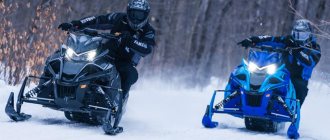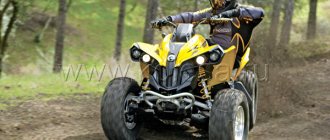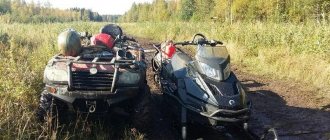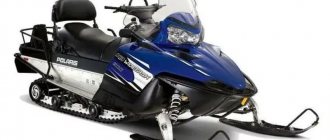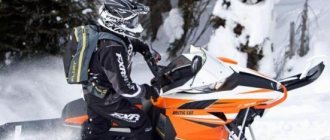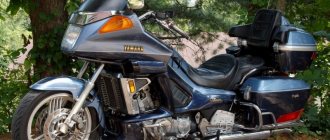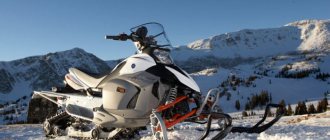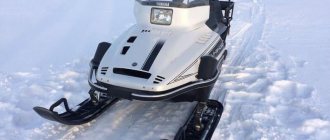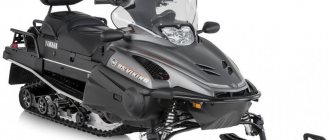Long track, three-inch lugs and new character
If you read our review of the Mountain Performance Inc. Turbocharged Yamaha M-TX 141 LE Snowmobile. (MPI), then you already know that the M-TX discussed in this article is fundamentally similar to the 141 LE. The Yamaha M-TX 162 LE is also a sled with character, but it's closer to the M-TX 153 than the short track version of the 141 LE. Otherwise, the newest Viper M-TX models are amazing mountain sleds.
Snowmobile Yamaha Viper m-tx 162 Le
Yamaha faces a tough challenge as mountain snowmobile enthusiasts increasingly turn their attention to models such as the Polaris AXYS RMK Pro and SKS, the Ski-Doo Summit X with the T3 Option Pack, and the Arctic Cat M8000 Sno Pro and Limited.
Many owners of mountain snowmobiles believe that they should be powered by a two-cylinder, two-stroke engine with a displacement of at least 800 cm3. High power-to-weight ratio is what makes a truly good snowmobile. We can't blame drivers for believing this theory. Let's just leave everything as it is.
Genesis's 1,049cc, three-cylinder, four-stroke engine with electronic fuel injection is a blank canvas on which the owner must paint in large strokes how much horsepower is hidden under the hood. In its basic configuration, the Yamaha Viper M-TX LE 162 performs very well. Thanks to the lightweight PowerClaw track with three-inch lugs and Yamaha drive couplings, the SR Viper M-TX chassis feels like it handles like a lightweight mountain sled with plenty of torque and plenty of horsepower.
However, if you order the LE 162 through a special spring program and install an MPI turbocharger, then this campy 135-horsepower engine turns from Clark Kent into Superman with 185 horsepower. And that's how the 162 LE Viper M-TX becomes an incredibly cool car. The power-to-weight ratio is impressive when the turbocharger comes into play.
The 185-190 horsepower turbocharged 162 M-TX spins with ease on a 15-inch-wide PowerClaw track with three-inch lugs. For this beast there will be no difficulty in climbing the highest mountain and driving through the deepest snow.
Don't forget that Arctic Cat pumped up their Pro Climb mountain chassis and that's what the Yamaha M-TX is built on.
FX Nytro MTX SE162: stylish and aggressive mountain snowmobile
The Yamaha Nitro snowmobile (Snowbike Yamaha FX Nytro) is a series of Japanese snowbikes with four-stroke three-cylinder engines with a displacement of 1049 cm3 and a net power of up to 175 horsepower (according to the manufacturer).
The first snowmobile of this model rolled off the assembly line in 2007, and then modernized versions of the snowmobile were regularly produced, both with minor changes in appearance and with tuning of entire components of the snowmobile. Yamaha's 2014 Nytro MTX comes in 153cm and 162cm tracks. The wide lip of the Snow Moto MT-9 provides good stability and controllability of the snowmobile, which is especially necessary when traveling in deep snow. According to owner reviews, the Nitro 162 model with a Camoplast Ascent track is more suitable for long mountain climbs, and the 153 model with a Camoplast Maverick transmission is less powerful, but benefits from its lighter weight.
Yamaha Viper m-tx 162 Le 2016
Now in its second year, the 2016 Yamaha Viper m-tx 162 Le outperforms last year's version when it comes to tackling deep mountain snow. Although we wish the 2016 model retained the 2015 LE's eye-catching white, blue, and orange color scheme, the 2016 LE 162 has a beefier track (the 2015 LE had a PowerClaw track with 2.6-inch lugs) ), and changes to the rear suspension make the long, tall sled perform nimbly. Improvements have also been made to the front suspension; they have a positive effect on boondocking in deep snow and driving across a slope.
The SR Viper M-TX 162 boasts new spindles forged from aluminum. They are angled back 10 degrees compared to the previous version, and are also folded in the middle to be flush with the lower side panels. The new spindles are 1.1kg lighter than last year's and feature new upper and lower arms. All these modifications made the M-TX 162 LE easy and manageable to operate.
Yamaha Viper m-tx 162 Le is equipped with a front anti-roll bar. The distance between the skis is adjustable from 876 mm to 978 mm, the optimal distance is 902-927 mm.
We really enjoyed last year's Viper M-TX 162 LE. But the slopes had to be chosen with caution due to the narrow ski stand. The skis kept diving into the soft snow, throwing up the driver and the snowmobile. This behavior was very annoying.
Underneath the 2016 SRV-M's front suspension is a new all-mountain ski that's 178mm wide at the tip and then tapers to 165mm where the hooks attach to the body of the ski. These new skis are similar to those once used on the Nytro MTX, but they feature a wider and deeper keel. Thanks to the new design, the snowmobile grips better on snow.
The front suspension of the Yamaha Viper m-tx 162 Le uses powerful Fox FLOAT 3 EVOL shock absorbers with a wide range of adjustment.
As for the advanced Dual Shock SR 162 rear suspension , there is a Fox Float EVOL shock absorber installed on the front rail, and a Fox FLOAT EVOL R shock absorber on the rear rail, which has an additional remote chamber. This camera gives you a lot of adjustment, you can adjust the suspension according to your weight, terrain, desired level of comfort, and you can also get rid of the “squat”. The rear sled frame has a torsion bar springless suspension design.
In addition, the rear suspension is uncoupled: its shock absorbers work independently of each other, and this allows the snowmobile to move in deep, loose snow. The new rear suspension keeps the sled's nose planted in the snow as you head down the slopes, especially with the 185-190 horsepower of the turbocharged version running through the track.
We liked the Yamaha Viper m-tx 162 Le regardless of whether it is equipped with an MPI turbocharger or not. Our first acquaintance with this clean and fresh snowmobile took place in January 2014. We noted that the revised rear suspension worked well in tandem with the improved front end, and the skis were mounted at 927mm, making the M-TX 162 LE feel like a very nimble four-stroke sled. The motor, as supplied from the factory, easily drives the PowerClaw mountain track with three-inch lugs.
And in February and March of this year we were lucky enough to sit behind the wheel of the M-TX LE 162 with an MPI turbocharger, the name LE means that the improved front and rear suspension keep the 185 “horses” firmly under the reins, but not too much.
Yamaha FX Nytro Specifications
The Yamaha Nytro snowmobile has left its competitors far behind. What will surprise the car in technical terms?
Parameters of the Nytro snowmobile, released in 2014:
- Camoplast2 Rip Saw tracks that prevent the machine from getting buried in the snow. The track, 381 mm wide, allows you to pass the most difficult sections of the mountain route.
- Four-stroke engine Yamaha Genesis 130FI with liquid cooling. Engine power – 130 hp.
- Electric starter.
- CVT transmission.
- YVXC clutch.
- Hydraulic disc brake.
- Dual Shock rear suspension with two gas shock absorbers.
- Front suspension with HPG shock absorber.
- Fuel tank volume – 27.7 l. For 100 km, a powerful car consumes approximately 15-20 liters of gasoline, depending on the route.
- Aluminum frame.
- Plastic body.
The basic version of the Yamaha Nitro has anti-slip coating and protection for: hands, belt, exhaust pipe, clutch, headlights.
Test drive YamahaFX Nytro X-TX
The competition between snowmobile manufacturers has become so fierce that the engineers of these companies are literally bending over backwards to organize a small technical revolution for the next new season.
The main “revolutionaries” of the 2009 season in the Yamaha snowmobile family are the FX Nytro X-TX crossover and the extreme “tourist” RS Venture GT. The FX Nytro X-TX device is a modification of the FX Nytro sports model series. Since their introduction in 2007, there has been one big complaint about Nytro cars - they desperately resist active control and strive to throw the rider off their “scruff” in almost every turn. Only experienced and physically strong riders could stay in the Nytro saddle at a fast pace. But even they complained about the oversteer characteristic of these “snowballs”. It is logical that in 2009, not only the new X-TX modification, but the entire FX Nytro model range received an improved front suspension.
In total, about thirteen changes were made to the front suspension design. The geometry of the horizontal and vertical arms has changed, due to which the center of the contact surface of each ski has moved forward. The angle of inclination of the front pillar has become sharper, which significantly facilitates the steering process in turns and has a positive effect on the overall stability of the vehicle at high speed. The distance between the skis has decreased slightly - from 1056 mm to 1053 mm, and their toe angle has changed from 22° to 25.8°. Like this! Somewhere a couple of millimeters is a minus, and somewhere a few degrees is a plus. Yamaha engineers, like sculptors, brought the design of the front suspension to technical perfection. However, it is known that there is no place for perfection in our world. But it was the seemingly insignificant (seemingly) design changes to the front suspension that made the FX Nytro series vehicles more controllable and friendlier towards their pilots.
Depending on the modification, FX Nytro snowmobiles are equipped with different shock absorbers. For example, on the thoroughbred R-TX SE, the front suspension is equipped with advanced Fox FLOAT-X Front shock absorbers. In the FX Nytro X-TX crossover model, the front shock absorbers are a little simpler - adjustable GYTR. However, simpler does not mean worse. After all, the FX Nytro X-TX is not an ordinary sports “lighter”, intended purely for high-speed “produbas” on a cross-country “comb”. The main “revolutionary” element in the Nytro X-TX is the rear suspension, which allows you not only to quickly “dust” along a prepared track, but also not be afraid to go out into loose snow. It is clear that there is a limit to everything. But if in order to “bury” a utility vehicle with a track 50 cm wide you need to show dexterity and experience, then in order to “bury” a sports unit up to the headlight in “powder”, no special talent is required. Just popped in - hello, take out a shovel and do some fitness in the fresh air.
The secret of the “revolutionary” versatility of the FX Nytro X-TX is that due to the 6-degree rise of the rear part of the guide rails of the Dual Shock CK 144 suspension, the track forms a different contact patch depending on the snow surface. The overall length of the track is 144 inches (3 m 65.7 cm). When driving on hard snow, the track operates like a short 121-inch (3 m 7.3 cm) sport track. On the cross-country track, the FX Nytro X-TX feels no worse than its purebred sports brothers in the model range. The snowmobile sensitively reacts to the pilot’s movements with its body, “tucks” into sharp turns without any problems, and is not afraid of springboard jumps. And don’t forget – a small contact patch opens up the opportunity to increase speed.
Once the FX Nytro X-TX hits a chaotically rough, snow-covered country track, the load on the track increases along its length to 136 inches (3 m 45 cm). The snowmobile has increased traction properties while maintaining stability and without significant losses in controllability and speed. According to the “full program” and to its full “growth”, the caterpillar begins to work on loose snow. The level of cross-country ability of the FX Nytro X-TX is hardly correct to compare with utilitarian cars, but for some “tourists” in the virgin snow, the Yamaha crossover will easily be a worthy competitor. Just don’t get too carried away with “loitering” in the deep “powder”. After all, the Genesis engine with a power of 130 “mares” in the X-TX is tuned for sports and speed, and not for pulling a dozen shot down wild boars out of a ravine. You should not expect trolleybus traction at low speeds from a high-speed engine. Well, if you make a mistake and over-gas while in a white field, dig, Shura, dig. Don’t leave equipment worth 406,000 rubles to the mercy of fate.
Especially for those who don’t smile at tapping out the “saber dance” with their teeth and only sometimes have the desire to “stick” the throttle all the way, Yamaha has prepared a new “tourist” model – the RS Venture GT. The 2009 model year RS Venture is radically different from its predecessors. Firstly, the three-cylinder 120-horsepower Genesis 120FI has undergone significant modernization. Despite the remaining “cubic capacity” of 1050 cm3, compared to the RS Venture engine of the 2008 model, the new power plant is one kilogram lighter, 5% more economical and 6 hp. more powerful.
Accordingly, the torque has increased in value, especially at low speeds. The second distinctive point is that the RS Venture is built on the new, progressive, second-generation Deltabox platform, which guarantees a comfortable fit and easy, predictable control. Contrary to its touring status, the RS Venture GT is capable of “burning” the track not only along a straight line. In my opinion, the RS Venture GT is not exactly a “tourist”; it would be more correct to say that it is a sports-touring class snowmobile. By the way, the external design of the device is designed in a sports-motorcycle style. Judge for yourself: the exhaust pipes are a la the Yamaha R1 sportbike; the rear trunk lid (volume 28 liters) is clearly copied from a sports car; the seat (with adjustable lumbar support) with its shape clearly hints at its close relationship with car seats. And all this beauty is offered to customers at a price of 410,000 rubles. Among competitors, the conversation about highly comfortable “tourists” in the basic configuration starts at 450,000 rubles.
Sports installation
Genesis 130FI – coasting
The Nytro X-TX model is equipped with a 4-stroke 3-cylinder Yamaha Genesis 130FI engine with a displacement of 1050 cm3. The engine was designed specifically for participation in snowcross competitions. In principle, it would not be difficult for Yamaha engineers to create a motor with a larger cubic capacity, but the ISR (International Snowmobile Racing) rules do not allow snowmobiles equipped with an engine with a displacement above 1050 cm3 to compete.
The Genesis 130FI became the first power plant on which Yamaha tested its Engine Braking Reduction System (EBRS) in professional racing conditions, created to minimize the effect of engine braking, so typical of 4-stroke engines. 2-stroke engines do not have this problem, which allows for better control of the snowmobile when coasting.
The main element of EBRS is the ISC (Idle Speed Control) air valve, which is electronically controlled and located in the intake manifold. The ISC valve changes the throttle valve settings, thereby controlling engine idle speed, bypassing the standard engine management system. When the engine is running at high speeds and the driver suddenly releases the throttle, the EBRS system allows a certain amount of air through the ISC valve and the engine is allowed to “breathe” bypassing the closed throttle valve - the engine braking effect is significantly neutralized. Although it was still not possible to completely overcome it.
Text: Automobiles Magazine
Digital dashboard.
The illuminated digits on the FX Nytro M-TXSE162 snowmobile's instrument panel display all key information. The speed of the snowmobile is displayed on a wide LCD display in both miles and kilometers per hour. In addition, the second screen, at the driver's discretion, can display tachometer, odometer (distance traveled) or round-trip mileage data. The panel also has indicator lights for fuel level and engine overheating, so the driver can easily monitor the operation of all snowmobile systems.
Comparison of Yamaha FX Nytro with competitors and analogues
Yamaha produces reliable and relatively inexpensive equipment. But despite this, Japanese snowmobiles have more than enough competitors. The main opponents are BRP, Arctic Cat and Polaris.
The competition for the Yamaha snowmobile was: Polaris Switchback Pro R 800, Arctic Cat XF 800 and Ski-Doo Renegade E-TEC 800. All machines are in the same price category and practically do not differ in technical characteristics. The only difference is power. The working volume of the Japanese is 1049 cubic meters. cm, and the same Canadian has only 799.5 cc.
There is competition within the company as well. The Yamaha Nitro snowmobile performs well not only in extreme conditions, but also on the track. The series is a worthy competitor to the Venture line of travel devices. At the same time, cars for driving in the mountains are much cheaper than tourists. The price of Ventura models ranges from 1.1 to 1.3 million rubles, and Nitro costs from 420 to 800 thousand rubles.
Yes, indeed, there is much more virgin snow in our country than well-groomed paths, where sports (read: fashionable in our country) models are at ease, and the one who thinks that in a machine for deep snow you will not get either an adrenaline drive or a thrill from "Grips". The mind-buster - FX Nytro M-TX. And it’s not just about wide skis and an unrealistically long track with huge “oars” - grousers: the machine’s trump card is its original concept, which implies absolute maneuverability in snow of any depth.
About technology and more
THE FIRST models of the “Nytro” line, presented by Yamaha several years ago, surprised with a very unusual design. There was not the slightest hint of a front fairing, the engine was located behind the front suspension, closer to the middle of the snowmobile, and the suspension itself seemed to originate directly from the headlight. The new snowmobile looks even more unusual - its second generation “FX Nytro” front suspension is like no other. There is no visible power element or springs. Instead, there are gas-filled shock absorbers from the famous Fox Float company. Rear – “Fox Float 2” of increased volume. The shock absorbers are adjustable to suit the track and driving style.
The genesis of the three-cylinder Genesis 130F1 engine with Mikuni multiport fuel injection and three heated throttle valves, each 41 mm in diameter, goes back to the legendary liter four-cylinder engine that was on the Yamaha R1 sports bike. The calling card of a four-stroke Yamaha engine is traditionally five-valve heads, with three intake valves and two exhaust valves. Having lost one cylinder during the evolution, but maintaining a working volume of 1,049 cubic meters. cm, the engine gained in weight, dimensions, and most importantly – in low-end traction.
Well, the most important thing about the “FX Nytro M-TX SE 162” is the already mentioned wide and long (38.1x411.5 cm) “Camoplast Maverick” track. It has a low angle of attack - only 18 degrees - for better maneuverability in deep snow. And the huge 5.7-centimeter spikes give the caterpillar a truly terrifying look.
If you ever have to choose between a four-stroke and a two-stroke snowmobile engine, I advise you to go for the four-stroke, although for the same displacement it will have less power than a two-stroke. But he has other trump cards, and impressive traction at low speeds is just one of them. In addition, it is simpler and, if you like, more pleasant to use: there is no need for unpleasant fuss with constant topping up of oil for two-stroke engines, which causes burnout, and strict control over its level (God forbid you mess up - and the end of the engine). A four-stroke engine needs an oil change only once a year. And I won’t say anything about the environment - every “green” person will tell you that a four-stroke engine is less harmful to the atmosphere.
Features and operation of the Nitro snowmobile
Yamaha's development has been appreciated by millions of fans of speed and extreme riding. The car performs well on the highway, in the mountains and on rough terrain. Of course, the owners are a little upset about the carrying capacity of the device; you can’t ride a snowmobile together, but this is not a touring model.
- Reliable and powerful Genesis engine, with a volume of 130 cc (base model) and 135 (XTX unit).
- High speed and maneuverability. The cruising speed of the car is 100 km/h.
- Low fuel consumption. Considering the engine power, the snowmobile is very economical.
The manufacturer did their best and made the Nitro a universal snowmobile. The only drawback is the price of original spare parts.
Comfort
When it comes to comfort, the Viper m-tx 162 Le is equipped with a vertical steering column that keeps the driver's shoulders in an optimal position while driving standing across a slope. The seat is low enough to easily cross your leg over, but in our opinion it could be seven centimeters lower. By the way, if we talk about the seat, the LE model purchased under a special program is equipped with heating. Mountain snowmobile drivers prefer an aggressive driving style, so they spend most of their time behind the wheel standing, but when you get home, it's so nice to sit down in a warm place.
Overall, the M-TX 162's riding position, with its upright steering column, properly sized handlebars and footpegs, and mountain harness, promotes an aggressive riding style befitting a mountain sled.
With an additional 50 horsepower produced by the turbocharger, the M-TX 162 LE can compete with lighter two-stroke rivals. When, after a slow drive over rough terrain, you enter the forest, you feel the weight of the chassis. It is quite possible to keep up with your comrades on light two-stroke machines, but you will have to try.
When you squeeze the gas full on a straight section of the highway or on a flat mountain slope, it doesn’t matter to the engine what altitude it operates at, since all 185-190 horsepower will be available at an altitude of 1200 to 3000 meters. You can conquer mountain peaks as easily as your friends on two-stroke machines, even turbocharged ones.
Don't worry if you can't order the Yamaha Viper m-tx 162 Le with the MPI turbocharger during the special program, this option will be available during the season, but at a higher price. But if you're used to riding in the mountains without a turbocharger, the LE version will give you many happy minutes, hours and days, and you'll save money, too. We can assure you that the LE engine is quite powerful and fuel efficient.
Yamaha easily coped with the task set before them, simply equipped the LE 162 M-TX with a turbocharger and provided drivers with 185 horsepower. But even without the MPI turbocharger, the 162 M-TX LE is no less attractive. You should give her time and attention.
Technical characteristics of Yamaha Viper m-tx 162 Le
- Engine: Four-stroke three-cylinder Yamaha Genesis with a volume of 1049 cm3; cylinder diameter/piston stroke—82 mm/66.2 mm; liquid cooling; electronic injection system 41 mm; dry sump lubrication system
- Power: 135 hp
- Drive: Yamaha YVXC drive clutch; Yamaha driven clutch; push-button electronic reverse
- Front suspension: Yamaha SRV-M high A-arm with aluminum Fox FLOAT 3 Evol shock absorbers; stroke—178 mm; new alpine skis
- Rear suspension: Yamaha Dual Shock SR 162 parallel rail with Fox Float Evol and Evol R high-pressure aluminum gas shock absorbers; stroke—419 mm
- Brake system: Hydraulic system with radial master cylinder and disc on the shaft
- Length: 3378 mm
- Height: 1260 mm
- Width: 1229 mm
- Ski distance: adjustable 876mm-978mm
- Track: 15" 162" 3.0 PowerClaw
- Weight: unknown
- Fuel tank capacity: 38 liters (regular gasoline)
- Equipment: Standard: heated seat, power outlet, push-button reverse, digital instrument panel, rear storage bag
Lightweight CF die-cast FX frame.
Integrating the chain guard into the chassis structure is one of the benefits of Yamaha's exclusive Controlled Flowdiecasting technology. By reducing the size of small air bubbles in the metal during the casting process, Yamaha engineers were able to cast thinner-walled and more complex, feature-rich components, allowing the chain housing to be cast directly into the snowmobile frame.
Model/modification history
Since 1996, Yamaha has produced the sports YZF1000R Thunderace, which formed the basis of the YZF R1. The distinctive features are: an inverted fork, an updated frame, and the latest generation Genesis engine. As a result, the rider received lighter hardware, a more powerful engine, efficient handling and improved ergonomics. The configuration was “tailored” for the track, but among ordinary people it also won many fans. The plastic was available in blue and red and white.
Interest in the “YuZF” (as it is called in the CIS) does not subside even today. The company continues to improve the bike, fueling demand.
How about self-development and improvement of the Yamaha YZF R1?
2000 – first restyling
